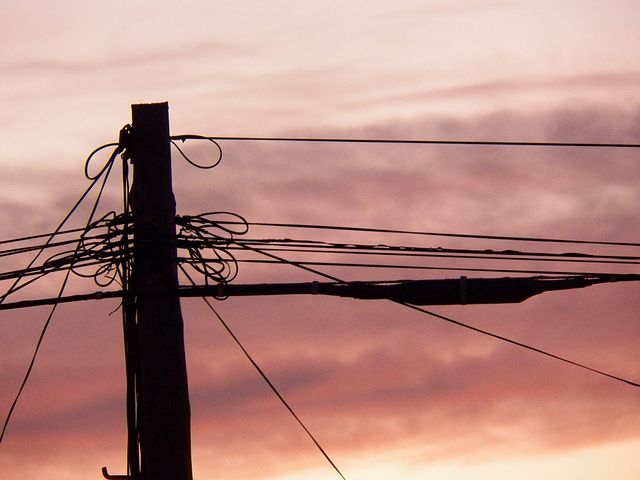Clean Energy Future and Valuation of Energy Efficiency - California and New York lead the way
 For all the excitement these days over the boom in renewables like wind and solar, and the growth of distributed "clean energy" systems, one truth that never changes is that the cleanest energy is the energy you never have to use.
For all the excitement these days over the boom in renewables like wind and solar, and the growth of distributed "clean energy" systems, one truth that never changes is that the cleanest energy is the energy you never have to use.
As major shifts cascade across the energy industry, a key question stakeholders are asking is, "How does the energy industry generally, and utilities and rate regulators specifically, best value and procure energy efficiency when and where it is needed on the grid?"
As with so many aspects of state energy policy today, California and New York lead the nation in tackling this question head-on in 2017. Both states are directing billions of dollars in new investments into clean energy, while also placing a high priority on development of new approaches to buying energy efficiency.
Rethinking energy efficiency procurement
For years, and in some areas decades, energy efficiency has typically been paid for through rebates and subsidies. For example, $10 coupons for buying energy-efficient light bulbs, or $200 rebates for upgrading to a high-efficiency water heater.
In California and New York, however, that era appears to be coming to a close. Both states are aggressively shifting towards procurement models that encourage the private sector to take on the delivery of efficiency through innovative technologies, performance-based programs, and financing initiatives.
In many states that have administered long-standing energy efficiency rebate programs, much of the low-hanging fruit has been picked; rebate programs are seeing diminishing returns. The traditional rebate model is proving decreasingly cost-effective in achieving deeper savings across diverse customer classes.
At the same time, technology development, in the form of devices such as programmable communicating thermostats and advanced control systems, is advancing faster than government-designed rebate programs ever can. Customers are demonstrating a powerful appetite for engagement, choice, and satisfaction, as new technologies like smart thermostats and electric vehicles impact the cost and convenience of energy. For the utility grid, efficiency and other behind-the-energy-meter resources have the potential to offer greater value through active demand management, to relieve localized and system constraints.

"The utility of the future is going to be more of a service provider, providing reliability, providing technical help, providing efficiency, and coordinating distributed generation with wholesale power," says Steve Isser, President of Energy Law and Economics President, a boutique consulting firm.1
New York's Energy Vision
Increased energy efficiency, and related programs like demand response to curb electric demand during periods when wholesale electric prices are spiking, is a pillar of both New York's and California's push to meet aggressive green energy mandates. Both states have adopted a standard of getting 50 percent of their energy from renewable/clean sources by 2030. In the longer term, New York aims to reduce statewide greenhouse gas (GHG) emissions by 40 percent from 1990 levels by 2030, and 80 percent by 2050.
The state also announced an initiative to invest up to $1.5 billion in major renewable energy projects. It would be the largest clean energy procurement by any state to date. The New York State Energy Research and Development Authority (NYSERDA) and New York Power Authority (NYPA) plan to invest up to $1.5 billion in wind, solar, large- and small-scale hydro, fuel cells, and other technologies - including 2.5 million megawatt-hours of renewably generated electricity.
New York State Public Service Commission Chairman John B. Rhodes said: "The Clean Energy Fund allows the State to make faster and greater progress towards Governor Cuomo's State Energy Plan and Clean Energy Standard goals, while reducing ratepayer collections. It also creates the demand for clean energy and the certainty we need to accelerate the growth of a dynamic clean tech economy that stimulates private investment and job creation."2
New York's 2050 goal for 50-percent year-round renewable energy represents nearly a doubling from current levels. But, as National Grid New York President Kenneth Daly has observed, "The only way to achieve stretch goals is to set them."
At the same time, New York is pursuing bold changes in energy efficiency. Consolidated Edison, for example, is moving the cost of energy efficiency (now paid for by a system benefit charge) into its rate base. This approach reflects the philosophy that efficiency shouldn't be an add-on or afterthought to buying energy, but rather get fully evaluated as utilities are determining how much energy they need to buy for their customers, and from what sources.
ConEd has also established a new position, "Vice President of Distributed Resource integration. Matt Ketschke, who fills that position, said: "They established my job specifically to think about, as we evolve the business model, and as we get more and more grid edge resources out there, what's going to have to change."3
Walter Rojowsky, an energy and utilities consulting expert with PA Consulting, said: "The transition to the next generation utility system will be made through the actions of the utility, vendors, investors, and customers, and the New York Public Service Commission has created a collaborative process that includes all of these parties."
California's Carbon Revolution
California addresses the efficiency evolution in a more distributed manner; more than 10 active proceedings in multiple state  agencies influence how efficiency will be planned for, procured, measured, and evaluated over the next 10 years. In 2016, California passed SB32, calling for a 40 percent reduction in greenhouse gas emissions (from 1990 levels) by 2030. One year earlier, California's SB 350 established a goal of doubling energy efficiency and increasing the renewable energy portfolio to 50 percent by 2030.
agencies influence how efficiency will be planned for, procured, measured, and evaluated over the next 10 years. In 2016, California passed SB32, calling for a 40 percent reduction in greenhouse gas emissions (from 1990 levels) by 2030. One year earlier, California's SB 350 established a goal of doubling energy efficiency and increasing the renewable energy portfolio to 50 percent by 2030.
Achieving even one of these goals will require a major shift from the status quo, as Governor Jerry Brown has acknowledged. "This is going to be a long march to transition the entire modern world to a decarbonized future,'' Governor Brown said two years ago.4 "Taking carbon out of the modern economy requires heroic efforts and tireless struggle. SB 350, in both efficiency and renewable energy, ratchet up the California commitment. We have the technological means and now we have the legal mandate to reduce carbon pollution."5
Andrew McAllister, a commissioner with the California Energy Commission, said "the state's highest priority is energy efficiency. To promote a clean energy economy, we must make it easier for markets to function and for people to make choices that achieve energy savings and drive consumer demand for energy services. In order to get scale, we have to utilize markets well and create the conditions within which they function properly." Commissioner McAllister also noted that "the savings go well beyond our state, because of California's sheer size, we can move markets."6
California has had the benefit of learning from some hard-earned, real-world experience. That's especially true in measuring efficiency savings via customer data. California has spent billions of dollars on smart meters that are widely considered to have provided less value than anticipated. In 2015, California lawmakers directed the utilities to begin measuring energy efficiency savings using the vast, detailed data generated by the smart meter technology.
This approach to measuring energy savings is called "normalized metered energy consumption" (NMEC). It is designed to determine the impact, and therefore value, of efficiency programs by using data from the customer's meter, instead of traditional engineering calculations. At the highest level, NMEC attempts to quantify how much electricity a customer used before efficiency measures were installed, as compared to how much after (adjusted, or "normalized," for weather extremes and other anomalous events that may drive big swings in energy use).
NMEC appears straightforward, but its implementation is fraught with questions and concerns. What is the right process for normalization? What happens when the efficiency savings are lost in the noise of the customer's typical energy consumption patterns? Who has access to, and who is responsible for, the security of a customer's energy use data? State regulators, utilities, and the efficiency industry are still working to develop the rules for using NMEC to calculate energy savings from California's next generation of programs.
California's investor-owned utilities are also making changes in how they procure efficiency. Earlier in 2017, they submitted five-year business plans detailing the strategy they will pursue for procuring energy efficiency, and increasing the portion of their efficiency that is outsourced from 20 percent to 60 percent, over the next three years.
As more delivery of efficiency resources gets outsourced, and NMEC is increasingly applied to measure savings in new programs, efficiency programs may begin to resemble wholesale resource purchases, like solar PPAs. Measuring savings at the meter, and relying on the market for delivery of this resource, will ultimately support broader opportunities for utilities to purchase efficiency in the future from third-party vendors.
Looking to our energy future
 California and New York are still working out how to improve energy efficiency. Other states will benefit from customizing a California or New York model to their local energy situation and policy preferences. There are already important lessons to be learned from New York and California; questions for utility managers and other stakeholders to consider, as they seek to make their own business model transitions a success, and protect their reasonable interests. Utilities, technology vendors, service providers, and their financial investors all face both threats and opportunities.
California and New York are still working out how to improve energy efficiency. Other states will benefit from customizing a California or New York model to their local energy situation and policy preferences. There are already important lessons to be learned from New York and California; questions for utility managers and other stakeholders to consider, as they seek to make their own business model transitions a success, and protect their reasonable interests. Utilities, technology vendors, service providers, and their financial investors all face both threats and opportunities.
"You have to make sure the utilities don't lose money by supporting energy efficiency,'' said Energy Law and Economics' Isser. "Make sure they don't have to wait years for a next rate case to recover their investment. A utility should be rewarded for performance somewhat like a private sector market rewards a business. If they do a better job, they are rewarded and if they do a worse job, they lose money."7
This will be an ongoing revolution for the utility business model across all 50 states. What California and New York are proving is that when it comes to a clean energy future, and promoting the cleanest energy of all - efficiency - they are leading the way with bold policies, and the regulations, strategies, and funding to make them come to life.
Carmen Henrikson is TRC Associate Vice President of Energy Services. She has has more than 17 years of experience in the advancement of clean and distributed energy resources with a focus on delivery and integration of energy efficiency, demand response and renewable technologies. At TRC, she provides strategic and policy direction for the design and management of utility-scale energy efficiency incentive programs. Ms. Henrikson serves as an Executive Committee member and Treasurer on the California Energy Efficiency Industry Council's Board of Directors. Ms. Henrikson holds an M.B.A. from the University of Michigan's Erb Institute of Global Sustainable Enterprise.
Bob Callender is a Vice President at TRC. Nationally recognized as a progressive leader in energy, Bob has over 20 years of experience as an innovator in energy policy and its implementation in the market. Prior to joining TRC, he was the Vice President of Programs for the New York State Energy Research and Development Authority (NYSERDA), where he oversaw NYSERDA's suite of energy efficiency programs. He was instrumental in introducing the whole building approach to New York's efficiency programs as well as developing innovative program financing mechanisms. Bob held several positions during his 24 year career at NYSERDA, including acting president and CEO. Mr. Callender is also a participating member of the New York REV Clean Energy Working groups and is a participating member of the NYS Public Service Commission's Clean Energy Advisory Council's Energy Efficiency Procurement and Markets Working Group. He has a bachelor's degree in government and management from American University in Washington, D.C., and a master's degree in public administration from the State University of New York at Albany.
TRC | www.trcsolutions.com
Volume: 2018 January/February








